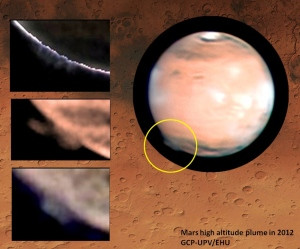Purple haze or pink nipple: just what IS that vast cloud hovering over Mars?

Astronomers admit having no ready explanation for two gigantic clouds which appeared high above the surface of Mars in 2012.
Although not spotted by spacecraft orbiting the Red Planet at the time, the clouds were noticed when older images taken by Hubble Space Telescope and amateurs were scrutinised.
At 200km, we shouldn't see any clouds, the atmosphere is too thin
The first cloud formed in 10 hours March 2012, at an altitude of 200 km and covering an area of up to 1000 km x 500 km. The cloud remained for around 10 days, changing shape constantly, but was at too high an altitude to be one of the dust storms which are a regular occurrence.
Dr Garcia Munoz from the European Space Agency said: "We know there are clouds on Mars, but clouds, up to this point, have been observed up to an altitude of 100km. And we are reporting a plume at 200km, so it is significantly different. At 200km, we shouldn't see any clouds, the atmosphere is too thin - so the fact we see it for 20 days in total is quite surprising."

The second cloud appeared a month later, at approximately the same altitude and same size. Since 2012, however, it has not been seen again. Among the theories being put forward are reflective clouds of water-ice, carbon dioxide or dust, but these are also thought improbable due to the cloud altitude.
Another explanation is a version of our own Northern lights (aurora borealis), though Dr Munoz said that would change everything we thought we knew about Mars's atmosphere.
"We know in this region on Mars, there have been auroras reported before. But the intensities we are reporting are much much higher than any auroras seen before on Mars or on Earth. It would be 1,000 times stronger than the strongest aurora, and it is difficult to come to terms that Mars has such an intense aurora."
The phenomenon was published in the scientific journal Nature in the hope other scientists may come up with a satisfactory explanation. If they can't, it is hoped the spacecraft now orbiting Mars or the many telescopes trained on the Red Planet may spot the clouds as they are being formed.
© Copyright IBTimes 2025. All rights reserved.






















